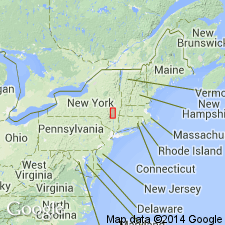
- Usage in publication:
-
- Katsbaan Bed
- Modifications:
-
- Named
- Dominant lithology:
-
- Siltstone
- AAPG geologic province:
-
- Appalachian basin
Summary:
Name Katsbaan Bed is here proposed for a bioturbated siltstone unit approximately 33 m above the base of the Otsego Member of the Mount Marion Formation (Hamilton Group) in east-central NY. Bed weathers dark gray to brown and is about 1 m in thickness. Considered a key marker bed, traceable along much of the outcrop belt. Upper and lower contacts of the unit are generally gradational with the surrounding silty shales. Taxa include pectenoid and pterinoid bivalves and diverse brachiopod fauna. Gastropods, bellerophonts, cephalopods, and bryozoans are numerous, along with crinoidal debris. The Katsbaan is one of four formally named Beds in this report. The Dave Elliott Bed occurs in the upper part of the underlying Berne Member of the Mount Marion. The Halihan Hill Bed defines the base of the Otsego Member and the Timmerman Hill Bed lies a few meters above the Katsbaan within the lower part of the Otsego.
Source: GNU records (USGS DDS-6; Reston GNULEX).
For more information, please contact Nancy Stamm, Geologic Names Committee Secretary.
Asterisk (*) indicates published by U.S. Geological Survey authors.
"No current usage" (†) implies that a name has been abandoned or has fallen into disuse. Former usage and, if known, replacement name given in parentheses ( ).
Slash (/) indicates name conflicts with nomenclatural guidelines (CSN, 1933; ACSN, 1961, 1970; NACSN, 1983, 2005, 2021). May be explained within brackets ([ ]).

